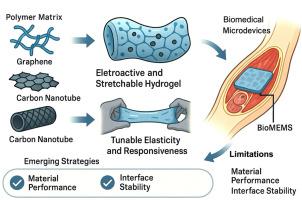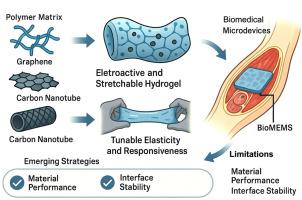生物医学微器件中用于导电电活性和可拉伸水凝胶的新兴纳米材料
IF 4.5
2区 化学
Q2 POLYMER SCIENCE
引用次数: 0
摘要
纳米材料与水凝胶的结合极大地促进了适用于生物医学微器件的高导电性、电活性和可拉伸材料的发展。这些水凝胶利用纳米材料独特的电、机械和生物相容性来开发支持动态生物相互作用的柔性界面。本文概述了这些水凝胶的基本性质,制备技术的最新进展,包括监测和表征,并强调了纳米材料在调节其弹性和反应性方面的重要性。此外,还特别关注了它们在生物医学微设备中的应用,如生物电子接口和微机电系统(BioMEMS)。讨论还讨论了与材料性能,界面稳定性和长期生物相容性相关的当前挑战,以及克服这些问题的创新策略。对多功能,自主和智能生物医学设备的新兴趋势进行了检查。这些发展将电活性、可拉伸水凝胶定位为下一代生物医学微技术的重要组成部分。本文章由计算机程序翻译,如有差异,请以英文原文为准。


Emerging nanomaterials for conductive electroactive and stretchable hydrogels in biomedical microdevices
The integration of nanomaterials into hydrogels has significantly advanced the development of highly conductive, electroactive, and stretchable materials suitable for biomedical microdevices. These hydrogels utilize the distinctive electrical, mechanical, and biocompatible qualities of nanomaterials to develop flexible interfaces that support dynamic biological interactions. This review outlines the fundamental properties of these hydrogels, recent advances in fabrication techniques, which also include monitoring and characterization, and emphasizes the importance of nanomaterials in adjusting their elasticity and reactivity. Additionally, special attention was given to their application in biomedical microdevices, such as bioelectronic interfaces and microelectromechanical systems (BioMEMS). The discussion also addresses current challenges related to material performance, interface stability, and long-term biocompatibility, as well as innovative strategies to overcome these issues. Emerging trends towards multifunctional, autonomous, and intelligent biomedical devices are examined. These developments position electroactive, stretchable hydrogels as vital components for next-generation biomedical microtechnologies.
求助全文
通过发布文献求助,成功后即可免费获取论文全文。
去求助
来源期刊

Polymer
化学-高分子科学
CiteScore
7.90
自引率
8.70%
发文量
959
审稿时长
32 days
期刊介绍:
Polymer is an interdisciplinary journal dedicated to publishing innovative and significant advances in Polymer Physics, Chemistry and Technology. We welcome submissions on polymer hybrids, nanocomposites, characterisation and self-assembly. Polymer also publishes work on the technological application of polymers in energy and optoelectronics.
The main scope is covered but not limited to the following core areas:
Polymer Materials
Nanocomposites and hybrid nanomaterials
Polymer blends, films, fibres, networks and porous materials
Physical Characterization
Characterisation, modelling and simulation* of molecular and materials properties in bulk, solution, and thin films
Polymer Engineering
Advanced multiscale processing methods
Polymer Synthesis, Modification and Self-assembly
Including designer polymer architectures, mechanisms and kinetics, and supramolecular polymerization
Technological Applications
Polymers for energy generation and storage
Polymer membranes for separation technology
Polymers for opto- and microelectronics.
 求助内容:
求助内容: 应助结果提醒方式:
应助结果提醒方式:


